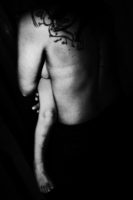Photography’s visceral qualities are inevitably tied to the visuals themselves: the use or absence of colour, the amount of contrast, the role technical shortcomings play (even when they’re artificial). But our understanding and perception of photography is also based on its history, and on the medium’s use in the various contexts we find it in. It’s mostly a theoretical exercise to imagine how we would perceive black-and-white photography if we did not know that this is how the medium started out. If we didn’t have the early history of black-and-white photojournalism what would we make of contemporary photojournalistic images that don’t have any colour?
There clearly is something to what a picture looks like that has us react in specific ways. On the surface, none of the various filters the popular app Instagram offers makes any sense – why produce a clearly artificial looking photograph when you can have something that’s much closer to what the camera’s lens saw? And many of the app’s users grew up never actually experiencing the use of, say, Polaroid Sx-70 film, never having asked a photo lab to cross process film, in fact never even have set foot into an actual photo lab.
But the filters that mimic those effects are popular (let’s call them effects for the sake of simplicity; my use of the term is not intended to be a value statement), and that has got to tell us something. I think most people writing about Instagram photography are making a big mistake when not taking this type of photography at face value (the same goes for “selfies,” the latest art craze).
But clearly applying some effect to a picture doesn’t necessarily guarantee a good picture. It just guarantees a picture that has that effect slapped on it. Again, this is not a value statement: you could instead use a view camera and still make incredibly bad pictures. You could spend all day, every day, in the darkroom and still make incredibly bad photographs. Quality photographs are not made with effects or gizmos; quality photographs are made by people who have a clear artistic vision. That’s the way this worked in the past, and it will always work that way (even though, I’ll admit, the idea of merit has always been under assault by artists who were much better at networking or hustling than at making good work; I’m sure you can easily think of examples).
I had to think of all of that when looking at Corinna Sauer‘s Home Story. I have a soft spot for these kinds of black-and-white pictures. They’re easy to like. They’re visceral, at least in terms of the way the tonalities are rendered. So I usually go from my initial reaction immediately to trying to look more carefully, to see whether there is something there beyond the visuals. And if yes, what is it I’m drawn to?




Photography is an act of paying attention to very specific details of the world, and Home Story can serve as a very obvious example of how this can work. Parts of the world are being extracted from it, are being given full attention, and the rest is made to fall away. Crucially, while there are many pictures that work well on their own, as a whole, they add up to something even more.
Particular attention is given to gestures, the same gestures that might subconsciously register, but that often are overlooked. Gestures, the way people use their hands and facial expressions, are very hard to deal with photographically. One of the complications appears to be that the moment we are made to look at a gesture, frozen in a photograph, we have to pay attention to something we usually do not think about. And then it gets weird very quickly.
It’s very hard to describe what it is that makes some gestures believable in photographs, but it’s certainly one of the most overlooked skills a photographer can have (the same seems true in many other forms of art: just look at how hands are rendered in painting or sculptures).
It is especially those gestures, the way they are treated photographically by Sauer, that makes Home Story succeed. This is no simple achievement, given that the overall look-and-feel of the visuals themselves focuses the viewer’s attention so much on them. And then, while seemingly often complex, the images all are much simpler than they would seem at first. Unlike in the case of most photojournalistic images that tend to overload the frame with details, here the viewer’s mind finds itself at rest after all, after the initial jolt of the harsh black and white.
